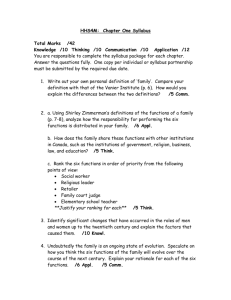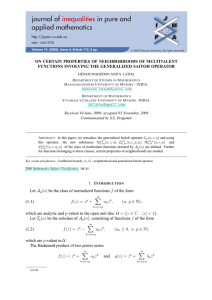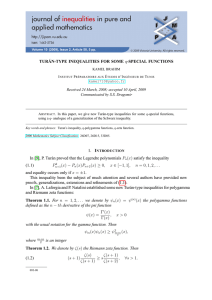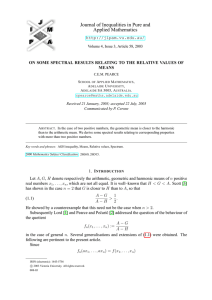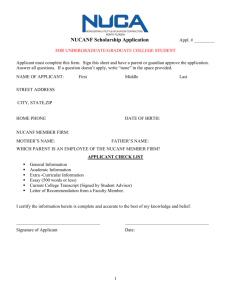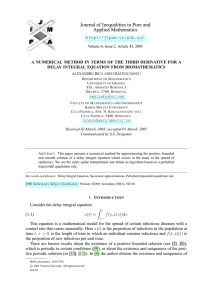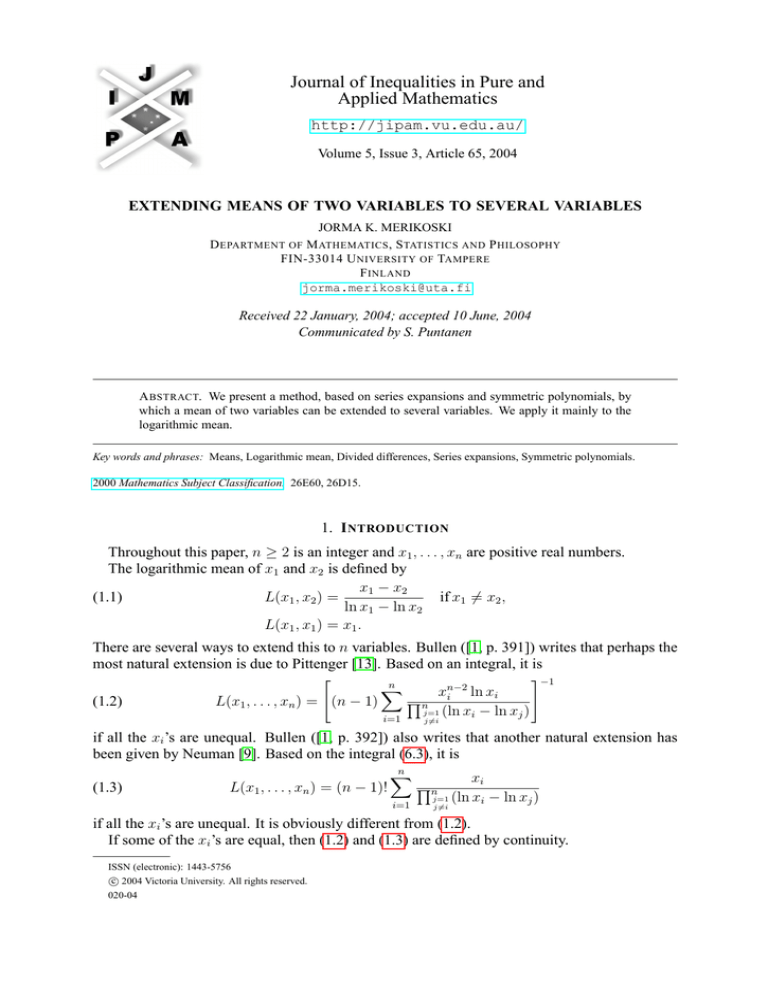
Journal of Inequalities in Pure and
Applied Mathematics
http://jipam.vu.edu.au/
Volume 5, Issue 3, Article 65, 2004
EXTENDING MEANS OF TWO VARIABLES TO SEVERAL VARIABLES
JORMA K. MERIKOSKI
D EPARTMENT OF M ATHEMATICS , S TATISTICS AND P HILOSOPHY
FIN-33014 U NIVERSITY OF TAMPERE
F INLAND
jorma.merikoski@uta.fi
Received 22 January, 2004; accepted 10 June, 2004
Communicated by S. Puntanen
A BSTRACT. We present a method, based on series expansions and symmetric polynomials, by
which a mean of two variables can be extended to several variables. We apply it mainly to the
logarithmic mean.
Key words and phrases: Means, Logarithmic mean, Divided differences, Series expansions, Symmetric polynomials.
2000 Mathematics Subject Classification. 26E60, 26D15.
1. I NTRODUCTION
Throughout this paper, n ≥ 2 is an integer and x1 , . . . , xn are positive real numbers.
The logarithmic mean of x1 and x2 is defined by
x1 − x2
L(x1 , x2 ) =
(1.1)
if x1 6= x2 ,
ln x1 − ln x2
L(x1 , x1 ) = x1 .
There are several ways to extend this to n variables. Bullen ([1, p. 391]) writes that perhaps the
most natural extension is due to Pittenger [13]. Based on an integral, it is
"
#−1
n
X
xn−2
ln
x
i
Qn i
(1.2)
L(x1 , . . . , xn ) = (n − 1)
j=1 (ln xi − ln xj )
i=1
j6=i
if all the xi ’s are unequal. Bullen ([1, p. 392]) also writes that another natural extension has
been given by Neuman [9]. Based on the integral (6.3), it is
n
X
xi
Qn
(1.3)
L(x1 , . . . , xn ) = (n − 1)!
j=1 (ln xi − ln xj )
i=1
j6=i
if all the xi ’s are unequal. It is obviously different from (1.2).
If some of the xi ’s are equal, then (1.2) and (1.3) are defined by continuity.
ISSN (electronic): 1443-5756
c 2004 Victoria University. All rights reserved.
020-04
2
J ORMA K. M ERIKOSKI
Mustonen [6] gave (1.3) in 1976 but published it only recently [7] in the home page of his
statistical data processing system, not in a journal. We will present his method. It is based on a
series expansion and supports the notion that (1.3) is the most natural extension of (1.1).
In general, we call a continuous real function µ of two positive (or nonnegative) variables a
mean if, for all x1 , x2 , c > 0 (or x1 , x2 , c ≥ 0),
(i1 )
(i2 )
(i3 )
(i4 )
(i5 )
µ(x1 , x2 ) = µ(x2 , x1 ),
µ(x1 , x1 ) = x1 ,
µ(cx1 , cx2 ) = cµ(x1 , x2 ),
x1 ≤ y1 , x2 ≤ y2 ⇒ µ(x1 , x2 ) ≤ µ(y1 , y2 ),
min(x1 , x2 ) ≤ µ(x1 , x2 ) ≤ max(x1 , x2 ).
Axiomatization of means is widely studied, see e.g. [1] and references therein.
2. P OLYNOMIALS C ORRESPONDING TO A M EAN
To extend the arithmetic and geometric means
1
x1 + x2
, G(x1 , x2 ) = (x1 x2 ) 2
2
to n variables is trivial, but to visualize our method, it may be instructive.
Substituting
A(x1 , x2 ) =
x1 = eu1 , x2 = eu2 ,
(2.1)
we have
(2.2)
(2.3)
A(x1 , x2 ) = Ã(u1 , u2 )
1
= (eu1 + eu2 )
2
u21
u22
1
=
1 + u1 +
+ · · · + 1 + u2 +
+ ···
2
2!
2!
u1 + u2
1 u2 + u22
1 u3 + u32
=1+
+ · 1
+ · 1
+ ··· ,
2
2!
2
3!
2
G(x1 , x2 ) = G̃(u1 , u2 )
1
= (eu1 eu2 ) 2
=e
u1 +u2
2
2
u1 + u 2
1 u1 + u 2
=1+
+
+ ···
2
2!
2
u1 + u 2
1 (u1 + u2 )2
1 (u1 + u2 )3
=1+
+ ·
+
·
+ ··· ,
2
2!
22
3!
23
(2.4) L(x1 , x2 ) = L̃(u1 , u2 )
eu1 − eu2
=
u − u2
1
u21
u22
+ · · · − 1 − u2 −
− · · · (u1 − u2 )−1
= 1 + u1 +
2!
2!
J. Inequal. Pure and Appl. Math., 5(3) Art. 65, 2004
http://jipam.vu.edu.au/
E XTENDING M EANS OF T WO VARIABLES TO S EVERAL VARIABLES
3
u21 − u22 u31 − u32
= u1 − u 2 +
+
+ · · · (u1 − u2 )−1
2!
3!
1 u2 + u1 u2 + u22
1 u3 + u21 u2 + u1 u22 + u32
u1 + u2
=1+
+ · 1
+ · 1
+ ··· .
2
2!
3
3!
4
All these expansions are of the form
1
1
P2 (u1 , u2 ) + P3 (u1 , u2 ) + · · · ,
2!
3!
where the Pm ’s are symmetric homogeneous polynomials of degree m. In all of them,
(2.5)
1 + P1 (u1 , u2 ) +
P1 (u1 , u2 ) =
u 1 + u2
= A(u1 , u2 ).
2
The coefficients of
(2.6)
m−1
Pm (u1 , u2 ) = b0 um
u2 + · · · + bm um
1 + b1 u1
2
are nonnegative numbers with sum 1. They are for A
1
1
b0 = , b1 = · · · = bm−1 = 0, bm = ,
2
2
for G
m −m
bk =
2
k
(0 ≤ k ≤ m),
and for L
1
.
m+1
Let µ be a mean of two variables. Assume that it has a valid expansion (2.5). Fix m ≥ 2, and
denote by Pm [µ] the polynomial (2.6). Its coefficients define a discrete random variable, denoted
by Xm [µ], whose value is k (0 ≤ k ≤ m) with probability bk . In particular, Xm [A] is distributed
uniformly over {0, m}, and Xm [G] binomially and Xm [L] uniformly over {0, . . . , m}. Their
variances satisfy
Var Xm [G] ≤ Var Xm [L] ≤ Var Xm [A],
b0 = · · · = bm =
which is an interesting reminiscent of
G(x1 , x2 ) ≤ L(x1 , x2 ) ≤ A(x1 , x2 ).
(2.7)
Let u1 , u2 ≥ 0, then (2.7) holds in fact termwise:
(2.8)
Pm [G](u1 , u2 ) ≤ Pm [L](u1 , u2 ) ≤ Pm [A](u1 , u2 )
for all m ≥ 1. The functions
1
Rm [µ](u1 , u2 ) = (Pm [µ](u1 , u2 )) m
are means. In particular, for A they are moment means
m
m1
u1 + um
2
= Mm (u1 , u2 ),
Rm [A](u1 , u2 ) =
2
for G all of them are equal to the arithmetic mean
Rm [G](u1 , u2 ) =
J. Inequal. Pure and Appl. Math., 5(3) Art. 65, 2004
u 1 + u2
= A(u1 , u2 ),
2
http://jipam.vu.edu.au/
4
J ORMA K. M ERIKOSKI
and for L they are special cases of complete symmetric polynomial means and Stolarsky means
(see e.g. [1, pp. 341, 393])
m1
m
m1
um+1
u1 + um−1
u2 + · · · + um
− um+1
1
1
2
2
Rm [L](u1 , u2 ) =
=
.
(m + 1)(u1 − u2 )
m+1
Since the Pm |µ]’s are symmetric and homogeneous polynomials of two variables, they can
be extended to n variables. Thus µ can also be likewise extended.
3. T RIVIAL E XTENSIONS : A AND G
Consider first A. By (2.2),
m
um
1 + u2
.
2
To extend it to n variables is actually as trivial as to extend A directly. We obtain
Pm [A](u1 , u2 ) =
Pm [A](u1 , . . . , un ) =
m
um
1 + · · · + un
,
n
and so
∞
X
1
A(x1 , . . . , xn ) =
Pm [A](u1 , . . . , un )
m!
m=0
∞
∞
X
X
um
um
1
n
+ ··· +
m!
m!
m=0
m=0
!
=
1
n
=
1 u1
x1 + · · · + xn
(e + · · · + eun ) =
.
n
n
Next, study G. By (2.3),
Pm [G](u1 , u2 ) =
u 1 + u2
2
m
,
which can be immediately extended to
Pm [G](u1 , . . . , un ) =
u1 + · · · + u n
n
m
,
and so
∞
X
1
G(x1 , . . . , xn ) =
Pm [G](u1 , . . . , un )
m!
m=0
m
∞
X
1
u1 + · · · + u n
=
m!
n
m=0
=e
u1 +···+un
n
1
1
= (eu1 · · · eun ) n = (x1 · · · xn ) n .
We present a “termwise” (cf. (2.8)) proof of the geometric-arithmetic mean inequality
(3.1)
G(x1 , . . . , xn ) ≤ A(x1 , . . . , xn ).
We can assume that u1 , . . . , un ≥ 0; if not, consider cG ≤ cA for a suitable c > 0. Let m ≥ 1.
Then
(3.2)
Pm [G](u1 , . . . , un ) ≤ Pm [A](u1 , . . . , un )
J. Inequal. Pure and Appl. Math., 5(3) Art. 65, 2004
http://jipam.vu.edu.au/
E XTENDING M EANS OF T WO VARIABLES TO S EVERAL VARIABLES
5
or equivalently
Rm [G](u1 , . . . , un ) ≤ Rm [A](u1 , . . . , un ),
(3.3)
since
m
m1
u 1 + · · · + um
u1 + · · · + un
n
≤
n
n
by Schlömilch’s inequality (see e.g. [1, p. 203]). Therefore (3.1) follows.
4. E XTENDING L
Let 1 ≤ m ≤ n. The mth complete symmetric polynomial of u1 , . . . , un ≥ 0 (see e.g. [1,
p. 341]) is defined by
X
Cm (u1 , . . . , un ) =
u1 i1 · · · un in .
i1 +···+in =m
(Here i1 , . . . , in ≥ 0, and we define 00 = 1.)
Let us now study L. Denote Qm = Pm [L]. By (2.4),
m−1
um
u2 + · · · + um
1 + u1
2
.
Qm (u1 , u2 ) =
m+1
This can be easily extended to
−1
n+m−1
Cm (u1 , . . . , un ).
(4.1)
Qm (u1 , . . . , un ) =
m
The corresponding mean,
1
Rm [L](u1 , . . . , un ) = Qm (u1 , . . . , un ) m ,
is called [1] the mth complete symmetric polynomial mean of u1 , . . . , un .
Thus we extend
∞
X
1
(4.2)
L(x1 , . . . , xn ) = 1 +
Qm (u1 , . . . , un ).
m!
m=1
We compute this explicitly. Fix m ≥ 2. Assume that u1 , . . . , un ≥ 0 are all unequal. We claim
that if 2 ≤ n ≤ m + 1, then Cm−n+1 (u1 , . . . , un ) is the (n − 1)th divided difference of the
function f (u) = um with arguments u1 , . . . , un . In other words,
(4.3)
Cm−n+1 (u1 , . . . , un ) =
Cm−n+2 (u2 , . . . , un ) − Cm−n+2 (u1 , . . . , un−1 )
.
u n − u1
(For n = 2, we have simply Cm−1 (u1 , u2 ) =
To prove this, note that for k ≥ 1
m
um
2 −u1
.)
u2 −u1
(4.4) Ck (u1 , . . . , un ) = ukn + uk−1
n C1 (u1 , . . . , un−1 )
+ · · · + un Ck−1 (u1 , . . . , un−1 ) + Ck (u1 , . . . , un−1 )
and
Ck (u1 , . . . , un ) = Ck (u1 , un ) + Ck−1 (u1 , un )C1 (u2 , . . . , un−1 )
+ · · · + C1 (u1 , un )Ck−1 (u2 , . . . , un−1 ) + Ck (u2 , . . . , un−1 ).
J. Inequal. Pure and Appl. Math., 5(3) Art. 65, 2004
http://jipam.vu.edu.au/
6
J ORMA K. M ERIKOSKI
Hence,
Cm−n+2 (u2 , . . . , un ) − Cm−n+2 (u1 , . . . , un−1 )
= Cm−n+2 (u2 , . . . , un ) − Cm−n+2 (u2 , . . . , un−1 , u1 )
= um−n+2
+ um−n+1
C1 (u2 , . . . , un−1 ) + · · · + Cm−n+2 (u2 , . . . , un−1 )
n
n
− um−n+2
− um−n+1
C1 (u2 , . . . , un−1 ) − · · · − Cm−n+2 (u2 , . . . , un−1 )
1
1
= (um−n+2
− um−n+2
) + (um−n+1
− um−n+1
)C1 (u2 , . . . , un−1 ) + · · ·
n
1
n
1
+ (un − u1 )Cm−n+1 (u2 , . . . , un−1 )
h
= (un − u1 ) Cm−n+1 (u1 , un ) + Cm−n (u1 , un )C1 (u2 , . . . , un−1 ) + · · ·
i
+ Cm−n+1 (u2 , . . . , un−1 )
= (un − u1 )Cm−n+1 (u1 , . . . , un ),
and (4.3) follows.
By a well-known formula of divided differences (see e.g. [4, p. 148]), we now have
Cm−n+1 (u1 , . . . , un ) =
n
X
um
i
i=1
Ui
,
where
n
Y
Ui =
(ui − uj ).
j=1
j6=i
Therefore, since
−1
1
n + (m − n + 1) − 1
(n − 1)!
=
,
(m − n + 1)!
m−n+1
m!
we obtain
1
(n − 1)!
Qm−n+1 (u1 , . . . , un ) =
Cm−n+1 (u1 , . . . , un )
(m − n + 1)!
m!
n
(n − 1)! X um
i
=
.
m!
U
i
i=1
Hence, and because the mth divided difference of the function f (u) = um is 1 if m = n − 1
and 0 if m ≤ n − 2, we have
L(x1 , . . . , xn ) = 1 +
=1+
∞
X
1
Qk (u1 , . . . , un )
k!
k=1
∞
X
1
Qm−n+1 (u1 , . . . , un )
(m
−
n
+
1)!
m=n
∞
n
X
1 X um
i
= 1 + (n − 1)!
m!
U
i
m=n
i=1
∞
X
n
1 X um
i
= (n − 1)!
m! i=1 Ui
m=n−1
J. Inequal. Pure and Appl. Math., 5(3) Art. 65, 2004
http://jipam.vu.edu.au/
E XTENDING M EANS OF T WO VARIABLES TO S EVERAL VARIABLES
7
∞
n
X
1 X um
i
= (n − 1)!
m! i=1 Ui
m=0
= (n − 1)!
= (n − 1)!
= (n − 1)!
= (n − 1)!
n
∞
X
1 X um
i
U
m!
i m=0
i=1
n
X
eui
i=1
n
X
Ui
eui
j=1 (ui − uj )
Qn
i=1
n
X
j6=i
xi
.
j=1 (ln xi − ln xj )
Qn
i=1
j6=i
Thus (1.3) is found.
5. N UMERICAL C OMPUTATION OF L
Mustonen [7] noted that, in computing L numerically, the explicit formula (1.3) is very unstable. He programmed a fast and stable algorithm based on (4.1), (4.2), and (4.4). His experiments
lead to a conjecture that, denoting Gn = G(1, . . . , n) and Ln = L(1, . . . , n), we have
1
lim (Gn+1 − Gn ) = lim (Ln+1 − Ln ) =
n→∞
n→∞
e
and
Gn
Ln
1
lim
= lim
= .
n→∞ n
n→∞ n
e
For Gn , these limit conjectures can be proved by using Stirling’s formula. For Ln , they remain
open.
6. I NEQUALITY G ≤ L ≤ A
It is natural to ask, whether
(6.1)
G(x1 , . . . , xn ) ≤ L(x1 , . . . , xn ) ≤ A(x1 , . . . , xn )
is generally valid.
For n = 2, this inequality is old (see e.g. [1, pp. 168-169]). Carlson [2] (see also [1, p. 388])
sharpened the first part and Lin [5] (see also [1, p. 389]) the second:
(6.2)
1
(G(x1 , x2 )M1/2 (x1 , x2 )) 2 ≤ L(x1 , x2 ) ≤ M1/3 (x1 , x2 ).
Neuman [9] defined (as a special case of [9, Eq. (2.3)])
!
Z
n
X
(6.3)
L(x1 , . . . , xn ) =
exp
ui ln xi du,
En−1
i=1
where u1 + · · · + un = 1,
En−1 = {(u1 , . . . , un−1 ) | u1 , . . . , un−1 ≥ 0, u1 + · · · + un−1 ≤ 1},
and du = du1 · · · dun−1 . He ([9], Theorem 1 and the last formula) proved (6.1) and reduced
(6.3) into (1.3).
Pečarić and Šimić [12] tied Neuman’s approach to a wider context. As a special case ([12,
Remark 5.4]), they obtained (1.3).
J. Inequal. Pure and Appl. Math., 5(3) Art. 65, 2004
http://jipam.vu.edu.au/
8
J ORMA K. M ERIKOSKI
Let V denote the Vandermonde determinant and let Vi denote its subdeterminant obtained by
omitting its last row and ith column. Xiao and Zhang [14] (unaware of [9]) defined
n
X
(n − 1)!
L(x1 , . . . , xn ) =
(−1)n+i xi Vi (ln x1 , . . . , ln xn ),
V (ln x1 , . . . , ln xn ) i=1
which in fact equals to (1.3). Also they proved (6.1).
We conjecture that (6.2) can be extended to
1
(G(x1 , . . . , xn )M1/2 (x1 , . . . , xn )) 2 ≤ L(x1 , . . . , xn ) ≤ M1/3 (x1 , . . . , xn ).
7. I NEQUALITIES Pm [G] ≤ Pm [L] ≤ Pm [A]
In view of (3.2) and (3.3), it is now natural to ask, whether (6.1) can be strengthened to hold
termwise. In other words: Do we have
Pm [G] ≤ Pm [L] ≤ Pm [A]
or equivalently
Rm [G] ≤ Rm [L] ≤ Rm [A],
that is
m1
m
1
u1 + · · · + u n
u1 + · · · + um
n
(7.1)
≤ Qm (u1 , . . . , un ) m ≤
n
n
for all u1 , . . . , un ≥ 0, m ≥ 1?
1
Fix u1 , . . . , un and denote qm = Qm (u1 , . . . , un ) m . Neuman ([8, Corollary 3.2]; see also [1,
pp. 342-343]) proved that
(7.2)
k ≤ m ⇒ qk ≤ qm .
The first part of (7.1), q1 ≤ qm , is therefore true. We conjecture that the second part is also true.
DeTemple and Robertson [3] gave an elementary proof of (7.2) for n = 2, but Neuman’s
proof for general n is advanced, applying B-splines.
Mustonen [7] gave an elementary proof of (7.1) for n = 2.
8. OTHER M EANS
Pečarić and Šimić [12] (see also [1, p. 393]) studied a very large class of means, called
Stolarsky-Tobey means, which includes all the ordinary means as special cases. They first defined these means for two variables and then, applying certain integrals, extended them to n
variables. It might be of interest to apply our method to all these extensions, but we take only a
small step towards this direction.
Let r and s be unequal nonzero real numbers. (Actually [12] allows s = 0 and [1] allows
r = 0, both of which are obviously incorrect.) Consider ([12, Eq. (6)]) the mean
1
r xs1 − xs2 s−r
·
,
(8.1)
Er,s (x1 , x2 ) =
s xr1 − xr2
where x1 6= x2 . Assuming that s 6= −r, −2r, . . . , −(n−2)r, this can be extended ([12, Theorem
5.2(i)]) to
1
"
# s−r
n
s+(n−2)r
X
(n − 1)! rn−1
xi
Q
(8.2)
Er,s (x1 , . . . , xn ) =
,
s(s + r) · · · (s + (n − 2)r) i=1 nj=1 (xri − xrj )
j6=i
where all the xi ’s are unequal.
J. Inequal. Pure and Appl. Math., 5(3) Art. 65, 2004
http://jipam.vu.edu.au/
E XTENDING M EANS OF T WO VARIABLES TO S EVERAL VARIABLES
9
To extend (8.1) by our method, we simply note that
1
s−r
xr1 − xr2
xs1 − xs2
Er,s (x1 , x2 ) =
s(ln x1 − ln x2 ) r(ln x1 − ln x2 )
1
L(xs1 , xs2 ) s−r
,
=
L(xr1 , xr2 )
which can be immediately extended to
(8.3)
Er,s (x1 , . . . , xn )
1
L(xs1 , . . . , xsn ) s−r
=
L(xr1 , . . . , xrn )
1
, n
) s−r
( n
X
X
xri
xsi
Qn
Qn
=
j=1 [s(ln xi − ln xj )]
j=1 [r(ln xi − ln xj )]
i=1
i=1
j6=i
j6=i
1
,
# s−r
"
n
n
r n−1 X
X
xsi
xri
Qn
Qn
.
=
s
j=1 (ln xi − ln xj )
j=1 (ln xi − ln xj )
i=1
i=1
j6=i
j6=i
This is obviously different from (8.2).
Unfortunately the problem of whether (8.3) indeed is a mean, i.e., whether it lies between the
smallest and largest xi , remains open.
A DDENDUM
Neuman ([10, Theorem 6.2]) proved the second part of (7.1) and [11] showed that (8.3) is a
mean.
R EFERENCES
[1] P.S. BULLEN, Handbook of Means and Their Inequalities, Kluwer, 2003.
[2] B.C. CARLSON, The logarithmic mean, Amer. Math. Monthly, 79 (1972), 615–618.
[3] D.W. DeTEMPLE AND J.M. ROBERTSON, On generalized symmetric means of two variables,
Univ. Beograd. Publ. Elektrotehn. Fak. Ser. Mat. Fiz. No. 634-677 (1979), 236-238.
[4] C.E. FRÖBERG, Introduction to Numerical Analysis, Addison-Wesley, 1965.
[5] T.P. LIN, The power mean and the logarithmic mean, Amer. Math. Monthly, 81 (1974), 879–883.
[6] S. MUSTONEN, A generalized logarithmic mean, Unpublished manuscript, University of Helsinki,
Department of Statistics, 1976.
[7] S. MUSTONEN, Logarithmic mean for several arguments, (2002). ONLINE [http://www.
survo.fi/papers/logmean.pdf].
[8] E. NEUMAN, Inequalities involving generalized symmetric means, J. Math. Anal. Appl., 120
(1986), 315–320.
[9] E. NEUMAN, The weighted logarithmic mean, J. Math. Anal. Appl., 188 (1994), 885–900.
[10] E. NEUMAN, On complete symmetric functions, SIAM J. Math. Anal., 19 (1988), 736–750.
[11] E. NEUMAN, Private communication (2004).
[12] J. PEČARIĆ
325–341.
AND
V. ŠIMIĆ, Stolarsky-Tobey mean in n variables, Math. Ineq. Appl., 2 (1999),
J. Inequal. Pure and Appl. Math., 5(3) Art. 65, 2004
http://jipam.vu.edu.au/
10
J ORMA K. M ERIKOSKI
[13] A.O. PITTENGER, The logarithmic mean in n variables, Amer. Math. Monthly, 92 (1985), 99–104.
[14] Z-G. XIAO AND Z-H. ZHANG, The inequalities G ≤ L ≤ I ≤ A in n variables, J. Ineq. Pure
Appl. Math., 4(2) (2003), Article 39. ONLINE [http://jipam.vu.edu.au/article.
php?sid=277].
J. Inequal. Pure and Appl. Math., 5(3) Art. 65, 2004
http://jipam.vu.edu.au/

